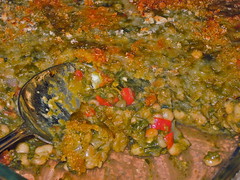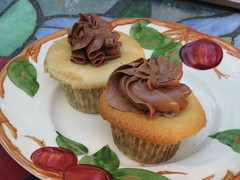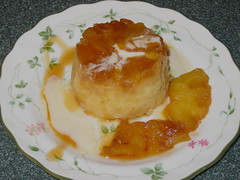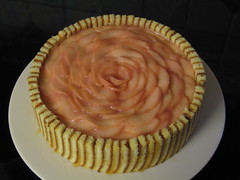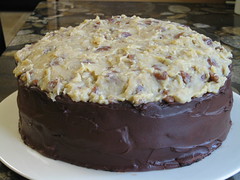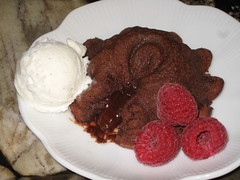 Rose's version of the "molten lava" chocolate cake is a flourless chocolate cakelet with a ball of ganache placed in the center of the batter before baking to produce the "lava" effect. My previous experience with a molten lava cake used the single-stage "underbaked cake" approach, which I had no trouble with that I recall and which is a good bit simpler. I'll have to do a direct comparison some time to see if the extra trouble in this recipe is worth it. It's really pretty hard to go wrong with a molten lava cake (as long as you do get the molten effect) in my book.
Rose's version of the "molten lava" chocolate cake is a flourless chocolate cakelet with a ball of ganache placed in the center of the batter before baking to produce the "lava" effect. My previous experience with a molten lava cake used the single-stage "underbaked cake" approach, which I had no trouble with that I recall and which is a good bit simpler. I'll have to do a direct comparison some time to see if the extra trouble in this recipe is worth it. It's really pretty hard to go wrong with a molten lava cake (as long as you do get the molten effect) in my book.
 First up was making the balls of ganache by pouring the hot ganache into the cups of an egg carton, lined with plastic wrap. Theoretically the ganache would then harden enough to be handled--in actuality the ganache stayed quite soft, and was hard to roll into balls even using the plastic wrap to push. I ended up forming the balls, or maybe "globs" is a better term, as I put them into the cake batter...especially after I realized I was 2 short, one from mis-counting, and one because I had even more batter. Well, sort of miscounting--there's some recipe confusion here too. The overall note says the recipe yield is nine 3-oz. cupcakes or seven 4-oz. cupcakes. The subsection for the ganache centers makes 8 tablespoons, meaning a total volume, as the instructions do say to pour the ganache into 9 cavities. I missed that, however, and apparently picked up the 8 tablespoons and prepared that many globs.
First up was making the balls of ganache by pouring the hot ganache into the cups of an egg carton, lined with plastic wrap. Theoretically the ganache would then harden enough to be handled--in actuality the ganache stayed quite soft, and was hard to roll into balls even using the plastic wrap to push. I ended up forming the balls, or maybe "globs" is a better term, as I put them into the cake batter...especially after I realized I was 2 short, one from mis-counting, and one because I had even more batter. Well, sort of miscounting--there's some recipe confusion here too. The overall note says the recipe yield is nine 3-oz. cupcakes or seven 4-oz. cupcakes. The subsection for the ganache centers makes 8 tablespoons, meaning a total volume, as the instructions do say to pour the ganache into 9 cavities. I missed that, however, and apparently picked up the 8 tablespoons and prepared that many globs. On to the cake itself: I had 5 3-oz. brioche tins (not silicon), 2 slightly larger ones, then had to fall back to silicone muffin cups for the remaining cakelets. The cake batter uses chocolate (62%), cocoa powder, and butter melted together. You whisk in a mixture of the egg yolks and crème fraîche, then a little egg white, then fold in the rest of the egg whites which have been beaten to a stiff peak with some sugar added. It did take me 4 eggs, not 3 plus an extra white, to get the specified weights of egg and yolk. I don't always decided to check, but when I do (and when it's an egg-heavy recipe), I'll need to add more egg yolk to get the specified amount.
On to the cake itself: I had 5 3-oz. brioche tins (not silicon), 2 slightly larger ones, then had to fall back to silicone muffin cups for the remaining cakelets. The cake batter uses chocolate (62%), cocoa powder, and butter melted together. You whisk in a mixture of the egg yolks and crème fraîche, then a little egg white, then fold in the rest of the egg whites which have been beaten to a stiff peak with some sugar added. It did take me 4 eggs, not 3 plus an extra white, to get the specified weights of egg and yolk. I don't always decided to check, but when I do (and when it's an egg-heavy recipe), I'll need to add more egg yolk to get the specified amount.My (10, not 9) little molds were on the edge of over-filled. The balls of ganache were placed on top and not pushed down, as instructed (so that wasn't a contributor to the overfilling, at least not at the start). The baked cakelets rose out of the pan (that was the "soufflé" part <g>) and the edges almost burned in about 12 minutes. The recipe said 10 minutes for the 3-oz. tins and 14 for 4-ounce muffin cups, but for silicone molds--I should have checked on my metal pans earlier. I expected the ganache to sink and become invisible, but instead I had deep pits in most of the cakelets.
 In only two, I think, did the batter mostly close over the ganache. In the end, the "lava" didn't seem to run out of the holes on re-heating, so the pits were not a problem.
In only two, I think, did the batter mostly close over the ganache. In the end, the "lava" didn't seem to run out of the holes on re-heating, so the pits were not a problem. In another complexity over the other recipe I've made, the cakelets are cooled after baking and refrigerated. Then each cake is microwaved individually just before serving to re-heat the center and let it flow--an advantage if it's not convenient to serve the cakes straight from the oven. I served them with a small scoop of ice cream to offset the intensity of the dark chocolate.
 Tasting opinions: It was unanimous--these are really good, and a nice serving size for our tastes without any adjustment except the bonus 10th cakelet. I do want to try my other recipe again before too long and compare the results to see if the extra trouble on this one was worth it--it's not a very involved recipe (especially compare to the charlotte or the pineapple pudding cakes), but if the simpler approach suits us as well as this one, we'll go with simpler.
Tasting opinions: It was unanimous--these are really good, and a nice serving size for our tastes without any adjustment except the bonus 10th cakelet. I do want to try my other recipe again before too long and compare the results to see if the extra trouble on this one was worth it--it's not a very involved recipe (especially compare to the charlotte or the pineapple pudding cakes), but if the simpler approach suits us as well as this one, we'll go with simpler.